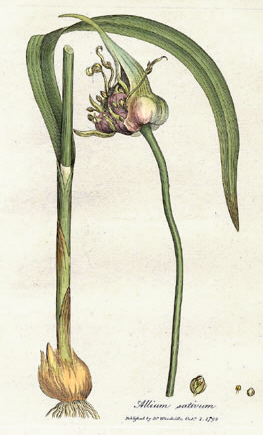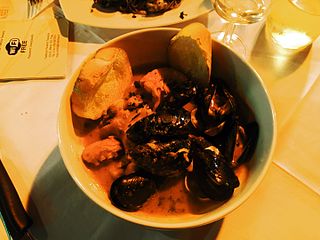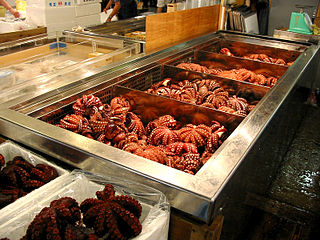
Garlic is a species of bulbous flowering plant in the genus Allium. Its close relatives include the onion, shallot, leek, chive, Welsh onion, and Chinese onion. It is native to Central Asia, South Asia and northeastern Iran. It has long been used as a seasoning and culinary ingredient worldwide, with a history of several thousand years of human consumption and use, including also use as a traditional medicine. It was known to ancient Egyptians and other ancient cultures for which its consumption has had a significant culinary cultural impact, especially across the Mediterranean region and across parts of Asia. It is produced globally but the largest producer is China which produced 73% of the world's supply of garlic in 2021. There are two subspecies and hundreds of varieties of garlic.

Tourin is a type of French soup, which is composed of onion, tomato, and/or garlic. It is also known as ouliat or le tourin d'ail doux, meaning 'smooth garlic soup'. Many regions have their own variations on the recipe. Typically, many recipes include as many as 20 cloves of garlic for a much stronger flavor. However other recipes include an equal measure of both onions and garlic to even out the taste.

Meze is a selection of small dishes served as appetizers in Armenian, Balkan, Greek, Levantine, and Turkish cuisines. It is similar to Spanish tapas and Italian antipasti. A meze may be served as a part of a multi-course meal or form a meal in itself. Meze are often served with spirits such as arak, rakia, raki, oghi, ouzo, or grappa at meyhane and ouzeri or at regular restaurants.

Bouillabaisse is a traditional Provençal fish soup originating in the port city of Marseille. The word is originally a compound of the two Provençal verbs bolhir and abaissar.

Allium vineale is a perennial, bulb-forming species of wild onion, native to Europe, northwestern Africa and the Middle East. The species was introduced in Australia and North America, where it has become an Invasive species.

Cypriot cuisine is the cuisine of the island of Cyprus.

Sofrito, sofregit, soffritto, or refogado is a basic preparation in Mediterranean, Latin American, Spanish, Italian and Portuguese cooking. It typically consists of aromatic ingredients cut into small pieces and sautéed or braised in cooking oil for a long period of time over a low heat.

Cacciucco is an Italian fish stew native to the western coastal towns of Tuscany. It is especially associated with the port city of Livorno, in Tuscany, and the town of Viareggio north of it.
Garlic routing is a variant of onion routing that encrypts multiple messages together to make it more difficult for attackers to perform traffic analysis and to increase the speed of data transfer.

Tunisian cuisine, the cuisine of Tunisia, consists of the cooking traditions, ingredients, recipes and techniques developed in Tunisia since antiquity. It is mainly a blend of Mediterranean and native Berber cuisine with Punic influences. Historically, Tunisian cuisine witnessed influence and exchanges with many cultures and nations like Italians, Andalusians, French and Arabs.

Ssamjang (Korean: 쌈장) is a thick, spicy paste used with food wrapped in a leaf in Korean cuisine. The sauce is made of fermented soy beans (doenjang), red chili paste (gochujang), sesame oil, onion, garlic, green onions, and optionally brown sugar.

Squid is eaten in many cuisines; in English, the culinary name calamari is often used for squid dishes. There are many ways to prepare and cook squid. Fried squid is common in the Mediterranean. In New Zealand, Australia, the United States, Canada, and South Africa, it is sold in fish and chip shops, and steakhouses. In Britain, it can be found in Mediterranean 'calamari' or Asian 'salt and pepper fried squid' forms in various establishments, often served as a bar snack, street food, or starter.

Yeonpo-tang or yeonpo-guk (연폿국) is a Korean soup made with beef, radish, tofu, and kelp stock.
Miruhulee boava is a Maldivian delicacy made of octopus tentacles braised in curry leaves, chili, garlic, cloves, onion, pepper, and coconut oil.

Nakji-bokkeum (낙지볶음) or stir-fried octopus is a popular dish in Korea that is relatively recent, with origins dating back only two centuries and first being introduced in the early 1960s.

People of some cultures eat octopus. The arms and sometimes other body parts are prepared in various ways, often varying by species and/or geography.

Buridda is an Italian seafood soup or stew originally from the Liguria region of Italy. Some preparations may be slow-cooked, while others are cooked in a relatively short amount of time. It has also been described as a stew, or as similar in texture to a stew.

Arroz negro is a Mexican dish made with rice, in which its dark color comes from black bean broth. The dark broth is made by cooking black beans with onion and butter in sufficient water. Rice is fried with garlic, then the bean broth is added, as well as epazote, serrano pepper, and salt. The rice is simmered until tender.




























